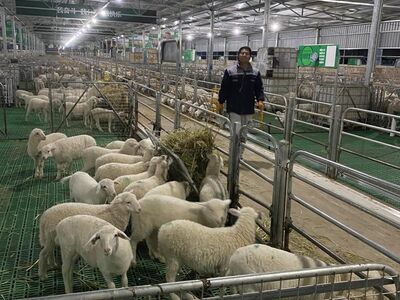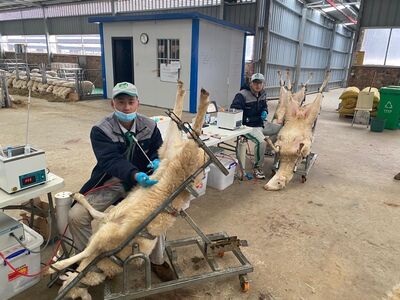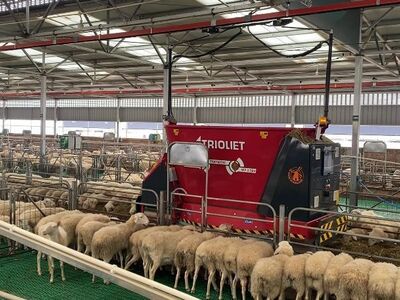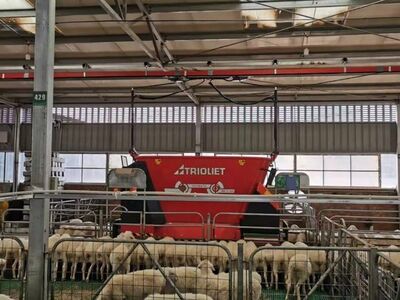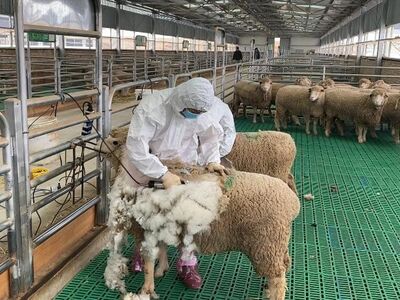Courtesy of Russ Davis
Russ Davis from D&D Consulting Group has spent the last five months, consulting and managing an exciting and innovative sheep project, in the community of Huanxian in Gansu Provence, China. Huanxian is about 1200km from Beijing near the Gobi Desert. The climate is extremely harsh, with winter temperatures reaching -30 degrees.
The project is being developed in partnership with local farmers, the Chinese Government, and private enterprise, to improve the quality and quantity of sheep meat produced in China. Approximately US$27 million has been invested in two farms. One with a capacity to hold 40,000 sheep and the other 32,000 sheep. All the sheep are housed in huge sheds with state-of-the-art facilities and modern technology. The sheds will soon be operating at full capacity.
$1million has been invested in a robotic feeder that distributes food to the sheep three times a day. Good hygiene practices are vital, and a misting system is used to sanitise the shed. Sensors alert automatic fans to kick in when the air ammonia levels reach nine parts per million. It only takes seven minutes for a complete change of air in the sheds. All the sheep are on gratings and the pens are scraped out twice per day. The manure is collected, composted, and then sold to farmers as fertilizer. Fresh water is available at will. Nothing[JS1] goes to waste.
The breeding ewes are based on a traditional Chinese breed called “Hu”. They are a highly efficient, fat-tail Romanov breed suited to the region. Hu have been bred for their meat.
The first objective of the farm is to produce FX ewes that will be sold to small producers and farm collectives. The Chinese eat approximately 13.2kg of sheep meat per year with the level increasing by 25 per cent this year due to weak pork production. All sheep meat is called “mutton”. The prime cuts are frozen, then sliced for “hotpots”. Traditionally the Chinese boil their meat. Every part of the sheep, except the hooves, is eaten including the offal – nothing is wasted. A leg shank may be served up to the table with the hoof still attached.
The second objective of the farms are to produce prime lambs for the domestic market. This is where the Poll Dorset comes into its own as the Terminal Sire. The best growth rates come from Poll Dorset second cross lambs with daily weight gains of 400+ grams per day. Lambs are weaned at 15-20kg. Ram lambs are sent to the feedlot and sold entire. Ewe lambs are classed and divided up according to quality, weight, and other breeding parameters. Lambs are sold into the domestic market at 50kg live weight and bring the equivalent of A$300 at an average of 25kg dressed. Sheep are fed on TMR consisting of 16% protein mixture from corn/wheat/sileage/oaten hay. The product from these farms are aimed at the elite end of the Chinese market. All the breeding ewes are artificially inseminated. As the numbers grow local farmers will be allocated breeding ewes to take to their own farms.
The ewes lamb in their pens. All the ewes are electronic tagged and monitored constantly for performance. Survival rates records are kept and sit at 87% for tw/tr and 97% for singles, at the moment. The wool is a by-product and is sold locally but of little value. Sheep are shorn in their pens, standing up with the shearer going from pen to pen. The shearers shear between 100-125 per day, so it takes a long time to shear all the sheep.
The Chinese Government has a five-year plan to revitalize agriculture. All land is leased in China and supported by the Government. This is a massive and ambitious project with Poll Dorsets playing a very important part.
